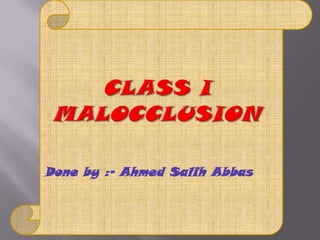
Dental Occlusion and Malocclusion Classification
- 1. Done by :- Ahmed Salih Abbas
- 2. Occlusion is the relationship of the maxillary and mandibular teeth when the jaws are in a fully closed position. Classification of teeth :- • Class I (normal occlusion) •Class I malocclusion •Class II malocclusion •Class III malocclusion *Prevalence of malocclusion :- Class I normal occlusion: 30% Class I malocclusion: 50-55% Class II malocclusion: 15% Class III malocclusion < 1% More class II in whites and more class III in Asians. Class III and open bite are more frequent in African than European populations
- 3. 1. Developmental causes : -The most encountered developmental disturbances are: -Congenitally missing teeth. -Malformed teeth. -Supernumerary teeth. -Impacted teeth. -Ectopic eruption. 2- Genetic causes :- Genetics play major role for malocclusion when there is discrepancy between size of the jaws & size of teeth. 3. Environmental causes: It is caused by injures which has two types:-
- 4. 1. Birth Injures: It comes under two major categories: Fetal molding (when a limb of the fetus presses another part leading to distortion of that part ). Trauma during birth from usage of forceps . 2-Injures throughout life : Trauma to teeth can lead to development of malocclusion in three ways: Damage to permanent tooth bud when primary tooth is traumatized. Premature loss of primary teeth leading to permanent tooth movement. Direct injury to permanent teeth. Note :- both dental and skeletal factors are incorporated in class 1 malocclusion. *Comparison of Mesiodistal Tooth Width between Normal Occlusion and Malocclusion :- In the malocclusion group the mesiodistal tooth width of the upper and lower central incisors, lower left lateral incisor, and lower first molars were significantly higher than in the normal occlusion group.
- 5. Bimaxillary proclination Increased incisal angle Spacing between teeth Normal molar and canine relationship Steep mandibular plane angles
- 6. SKELETAL FEATURES: Harmonious face Straight to convex profile Nothing really abnormal * Diagnosis :- -History -Clinical examination -Study models -Radiography OPG. Periapical radiographs . Lateral cephalometrics.
- 7. • Crowding: the most significant contributor to malocclusion • Vertical problems: open bites or deep bites • Transverse problem: relatively rare. ** SPACING :- 1-Generalized: Eliminate the cause. 2-Microdontia -Eliminate spaces between anteriors,leaving a space between canine and 1st premolar -Prosthesis 3-Spacing with proclination: Labial bow Elastics with fixed or removable appliance.
- 8. Localized spacing with proclination:- Labial bow with finger spring :-
- 9. -Eliminate cause i.e. high labial frenum attachment. -Removable appliances:- #Finger spring. #Finger spring with labial bow. #Split labial bow. -Fixed appliances: Pin and tube appliance.
- 11. Analyze space discrepancy using model analysis. Treatment is planned on the amount of space required. Mild Crowding: If the space discrepancy is up to 4mm: usually resolves without extraction. Proximal stripping Alignment of teeth by labial bow, finger spring. Moderate crowding: If space discrepancy is in the range of 5-9mm, treated without extractions by :- -Arch expansion -Molar anchorage or -Enamel reduction. Severe crowding : *Patients with space discrepancy of 10 mm or more: Extract all 1st premolars Retract canine by canine retractor Align anteriors by labial bow Retention by Hawley’s retainer.
- 13. ANTERIOR :- -Z-spring with posterior bite plane. -Expansion screw with posterior bite plane.
- 14. *POSTERIOR :- -Single tooth: Cross-elastics -Unilateral: Unilateral expansion screw Functional appliance -Bilateral: # Maxillary expansion is done to relieve cross bite by: # Coffin spring Quadhelix appliance :-
- 15. A patient with his upper right lateral incisor and upper left central incisor in crossbite. B, The lingual inclination of the teeth in crossbite-a favorable condition. C and D, A fixed appliance in the upper arch and a removable acrylic posterior bite block in the lower arch that opened the bite enough to easily move the teeth forward out of crossbite. E and F, The occlusion and upper arch after removal of the appliances.
- 17. ANTERIOR: ◦ Eliminate habit Thumb sucking Tongue thrust Mouth breathing ◦ Skeletal openbite i. during mixed dentition: Frankel IV or chin cap with high pull headgear ii. In permanent dentition,before puberty Fixed appliance with box elastics iii. In permanent dentition after puberty: Surgery ◦ If due to supra-erupted posteriors: Posterior segmental osteotomy
- 19. Single Tooth: Removable Appliance: Couple force by flapper spring/ double cantilever spring and labial bow Semi-fixed Appliance: Whip spring High labial bow with soldered ‘T’ spring Multiple rotations: Treated by fixed appliance Overcorrection is done and retention is given for atleast 1 year….
- 20. High Labial bow T spring
- 22. Extract all 1st premolars, or 1st molars. Treatment depends on angulation of canine: Distally inclined canine: Retract canine and align incisors using retainers Mesially inclined canine: Fixed appliance
- 28. YOU !!
